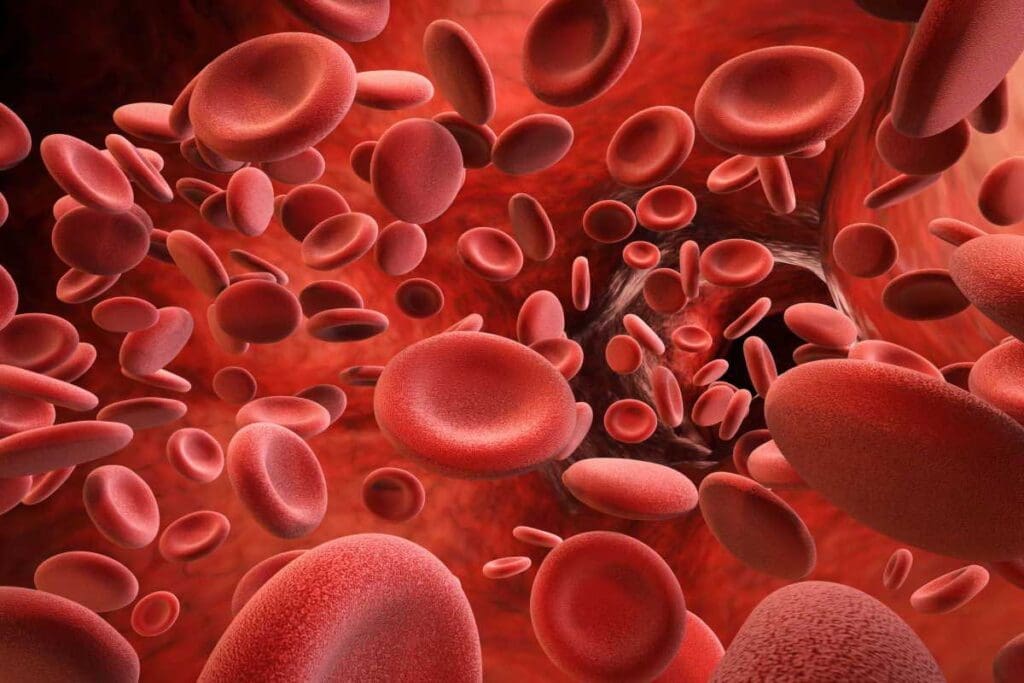Last Updated on November 17, 2025 by Ugurkan Demir
Expectant mothers should know about the dangers of blood clotting disorders during pregnancy. The CDC says pregnancy raises the risk of blood clots nearly fivefold. This high risk can cause serious health problems if not handled right.

We know how vital it is to get medical help and support quickly. At Liv Hospital, we stress the importance of knowing and understanding clotting disorders. By being informed, expectant mothers can take steps to have a healthy pregnancy.
Pregnancy raises the risk of blood clotting disorders. It’s key to know about these conditions. If not managed, they can cause serious problems.
Blood clotting disorders happen when the body makes blood clots too often. This can cause serious issues like deep vein thrombosis (DVT) or pulmonary embolism (PE). “The American Society of Hematology notes that pregnant individuals are at a higher risk for blood clots due to increased blood clotting to reduce blood loss during labor and delivery, and decreased blood flow to the legs.” It’s important for pregnant women to understand these risks to get the right care.
Blood clotting disorders affect how blood clots. Pregnancy ups the risk due to blood volume and clotting factor changes. We watch for signs like deep vein thrombosis (DVT) and pulmonary embolism (PE) in expectant moms.
Pregnancy is a clotting risk due to more blood, pressure, and clotting factors. Age, obesity, and family history also play a part. These factors raise the risk of clotting disorders during pregnancy.
DVT signs include leg pain, swelling, and redness. PE symptoms are shortness of breath, chest pain, and coughing. We stress the need for quick action if these symptoms appear.
Yes, clots can block placental blood flow. This can lead to issues like fetal growth restriction, preterm labor, or pregnancy loss. We closely monitor mothers with clotting disorders to prevent these problems.
Management includes screening, anticoagulation therapy, and follow-up care. We tailor our approach to each mother’s needs for the best outcomes.
No, clotting during pregnancy is never normal. While some clotting changes are expected, actual disorders need medical attention. We work with expectant mothers to identify and manage any clotting issues.
Antiphospholipid syndrome is an autoimmune disorder that increases clotting and pregnancy risks. We provide specialized care for mothers with this condition to ensure a healthy pregnancy.
While some risks are unavoidable, a healthy lifestyle and hydration can help. Following our screening and monitoring protocols also reduces clotting disorder risk during pregnancy.
Anticoagulation therapy is key in managing clotting disorders during pregnancy. We closely monitor mothers on this therapy to ensure the best outcomes for both mother and baby.

Pregnancy makes the body more prone to clotting due to several changes. The body makes more blood clotting factors to prevent too much bleeding during labor. But, this can also raise the risk of harmful clots.
As the uterus grows, it can press on the veins in the legs and pelvis. This slows down blood flow and increases clot risk.
Knowing these changes helps expectant mothers spot the risks and symptoms of blood clotting disorders during pregnancy.
Pregnancy makes blood clots more likely, almost five times more. This is because the body changes a lot to get ready for childbirth.
When you’re pregnant, your body changes to help prevent bleeding during delivery. It makes more blood clotting factors. This can raise the chance of blood clots. Also, the growing uterus can make blood pool in your legs, raising clot risk even more.

Some things can make blood clotting risks even higher during pregnancy. These include a history of blood clots, being overweight, and being older when pregnant. Knowing these risks is key to managing them.
| Risk Factor | Description | Impact on Clotting Risk |
| Personal History of Blood Clots | Previous experience of deep vein thrombosis or pulmonary embolism | Significantly increases risk |
| Family History of Blood Clots | Close relatives having experienced blood clots | Increases risk, if relatives were under 50 |
| Obesity | Having a BMI over 30 | Moderately increases risk due to additional pressure on veins |
| Advanced Maternal Age | Pregnancy at 35 years or older | Gradually increases risk with age |
Understanding these risks and body changes during pregnancy helps. Expectant mothers and healthcare providers can work together to lower blood clotting risks.
Expectant mothers should know the signs of blood clotting disorders. Quick action can greatly improve health outcomes. Blood clotting issues in pregnancy can show up in various ways. Deep Vein Thrombosis (DVT) and Pulmonary Embolism (PE) are two serious conditions.
DVT symptoms often appear in the affected limb. The National Blood Clot Alliance says common signs include swelling, pain, or tenderness.
A Pulmonary Embolism happens when a blood clot travels to the lungs. This can be very dangerous. Symptoms of PE include:
| Condition | Common Symptoms |
| Deep Vein Thrombosis (DVT) | Swelling, pain, tenderness in the leg |
| Pulmonary Embolism (PE) | Difficulty breathing, chest pain, coughing up blood |
Pregnant women should get medical help right away if they notice these symptoms. Early treatment can greatly lower the risk of serious problems from blood clotting disorders during pregnancy.
It’s vital for pregnant women to know about blood clotting disorders. These disorders can affect both the mother and the baby during pregnancy.
Blood clots in the placenta can block blood flow between the mother and the fetus. This can cause serious problems, like slow fetal growth and even death. The American College of Obstetricians and Gynecologists (ACOG) stresses the dangers of placental blood clots.
Blocked blood flow means the fetus might not get enough nutrients and oxygen. This is a medical emergency that needs quick attention.
Pregnancy issues like preeclampsia and placental abruption raise the risk of blood clots. Women with these problems need careful watching and sometimes preventive steps to avoid clots.
Pregnancy problems can make blood clotting more likely. So, doctors must watch closely and act fast to manage these risks.
Antiphospholipid syndrome (APS) is an autoimmune disorder that raises blood clotting risk in pregnancy. Women with APS need special care to manage their condition and avoid complications. This might include blood thinners and regular check-ups.
APS can cause repeated miscarriages and other pregnancy issues. This shows the need for specific treatment plans.
Some blood clotting changes are normal in pregnancy. But actual clotting is not okay. If you have symptoms like leg pain or swelling, see a doctor right away.
Knowing clotting in pregnancy is abnormal helps women get help quickly. This can prevent serious problems.
Managing blood clotting disorders in pregnancy is key to avoiding problems. We’ll look at the main ways to handle these conditions. This ensures the best results for both mom and baby.
Pregnant women with blood clotting history or other risks need careful checks. Early spotting of issues helps doctors create a tailored care plan. This might mean more prenatal visits and special tests to watch clotting risks.
Women at high clotting risk might need anticoagulation therapy. This treatment stops blood clots from forming. We weigh the good and bad of this therapy to keep mom and baby safe.
Keeping a close eye on blood clotting disorders is essential during pregnancy. Regular check-ups and tests help doctors tweak treatment plans. This way, expectant moms can feel secure throughout their pregnancy.
It’s key for expectant mothers to understand blood clotting disorders and pregnancy. Pregnancy raises the risk of blood clots by nearly five times. It’s vital to know the signs of deep vein thrombosis (DVT) and pulmonary embolism (PE).
We’ve shared seven important facts about blood clotting during pregnancy. These include the reasons behind the increased risk, high-risk factors, and how to manage them. The Centers for Disease Control and Prevention (CDC) emphasize the need for awareness and prevention to lower blood clot risks during pregnancy.
By staying informed and taking action, women can safeguard themselves and their babies from clotting issues. Our goal is to offer top-notch healthcare and support. We want our readers to feel confident in handling pregnancy’s challenges.
Together with healthcare providers, expectant mothers can have a healthier pregnancy. Knowing about clotting disorders and getting medical help on time are key to avoiding complications.
Blood clotting disorders affect how blood clots. Pregnancy ups the risk due to blood volume and clotting factor changes. We watch for signs like deep vein thrombosis (DVT) and pulmonary embolism (PE) in expectant moms.
Pregnancy is a clotting risk due to more blood, pressure, and clotting factors. Age, obesity, and family history also play a part. These factors raise the risk of clotting disorders during pregnancy.
DVT signs include leg pain, swelling, and redness. PE symptoms are shortness of breath, chest pain, and coughing. We stress the need for quick action if these symptoms appear.
Yes, clots can block placental blood flow. This can lead to issues like fetal growth restriction, preterm labor, or pregnancy loss. We closely monitor mothers with clotting disorders to prevent these problems.
Management includes screening, anticoagulation therapy, and follow-up care. We tailor our approach to each mother’s needs for the best outcomes.
No, clotting during pregnancy is never normal. While some clotting changes are expected, actual disorders need medical attention. We work with expectant mothers to identify and manage any clotting issues.
Antiphospholipid syndrome is an autoimmune disorder that increases clotting and pregnancy risks. We provide specialized care for mothers with this condition to ensure a healthy pregnancy.
While some risks are unavoidable, a healthy lifestyle and hydration can help. Following our screening and monitoring protocols also reduces clotting disorder risk during pregnancy.
Anticoagulation therapy is key in managing clotting disorders during pregnancy. We closely monitor mothers on this therapy to ensure the best outcomes for both mother and baby.
Subscribe to our e-newsletter to stay informed about the latest innovations in the world of health and exclusive offers!